[evaluation] what is the difference in the taste of sunburn and water-washed Sakuran? Which tastes better?
For professional baristas, please follow the coffee workshop (Wechat official account cafe_style)
In March this year, in the China Regional Cooking Competition held in Shanghai, a bean from Ethiopia, Africa, shook one expensive pedigree after another, fought back one by one, and was only narrowly defeated by the champion's Finca Deborah Rose Summer (last year's Wu Zelin's world champion beans), ranking the runner-up. This bean is Sunshine Sakuran from Humbera, Ethiopia.

Origin information
Continent: Africa
Country of ownership: Ethiopia
Origin: Guji Guji producing area, Hambella Wamena area, Dimtu Village, Buku able Manor.
Coffee bean seed: Heirloom (Ethiopian native bean seed)
Altitude: 2250-2350m
Introduction of buku able Buku Agboola Manor in Hambella Wamena Humbera region, Guji Guji region, Ethiopia
Only the sun-tanned coffee beans produced by "Buku Abel" in Hambella producing area are the real Sakuran.
Hambella (Humbela) is located in the largest coffee producing area of Ethiopia, GUJI, and the west is opposite the mountain of Yegashefi kochore, which is the highest sub-area in Ethiopia.
At present, there are nearly 20 processing plants in the Hambella producing area, and of all the manors and processing plants, only the sun-tanned coffee from Buku Abel Manor is what we call this Sakuran.

Buku Abel is a small village surrounded by mountains on the African continent at an altitude of 2280 meters. December is its coffee harvest season. Whenever the mountains are covered with red and mature coffee cherry, the village is neatly arranged on African tanning beds. This is where "Sakuran" deals with.
All the coffee trees in Buku Abel Manor are planted at an altitude of 2250 to 2350 meters above the hillside. The red fructose picked by farmers does not begin to be treated in the sun until the sugar content is more than 30. The humidity of the red fruit needs to be ensured in the first two days of the sun, so that it has time to fully ferment. At night, the temperature here will drop to about 12 degrees, which ensures that the red fruit will not be overfermented.

After 18 days of sun treatment, the peel and pulp have been completely dehydrated, and we can easily get the coffee raw beans inside. Pack the raw beans and put them in a warehouse with 12-22 degrees Celsius and 45-55% humidity. After about 50 days of bean cultivation and further dehydration, shelling and screening are carried out when the moisture content reaches about 11% for formal market sale.
Award winning situation
Winner of the harvest season Ethiopia National Taste of Harvest Competition (Ethiopian Coffee Competition) in 2016 / 2017
Runner-up in 2017 Regional Africa Taste of Harvest Competition (African Coffee Raw Bean Competition)
Sun sun Huakui VS washing Huakui
Two different [raw bean] treatment methods:

Natural solarization (African drying bed):
Spread the coffee fruit directly on the cement floor or on the drying rack in order to make the coffee dry and easy to preserve. It usually depends on the weather, and the drying time is about 2-4 weeks.
Coffee usually used for commercial purposes will be dried on the cement floor. Keep rolling the coffee fruit in time so that the back of the coffee is heated evenly, which is good for drying, and at the same time, it also avoids mildew caused by the bottom touching the ground for too long.
Hand-selected fruits and coffee beans used to make boutique products are treated in the sun with African Bed (African drying bed). Coffee fruits are sunbathed on transparent beds with mesh, and the thickness of the shelves varies according to local conditions.
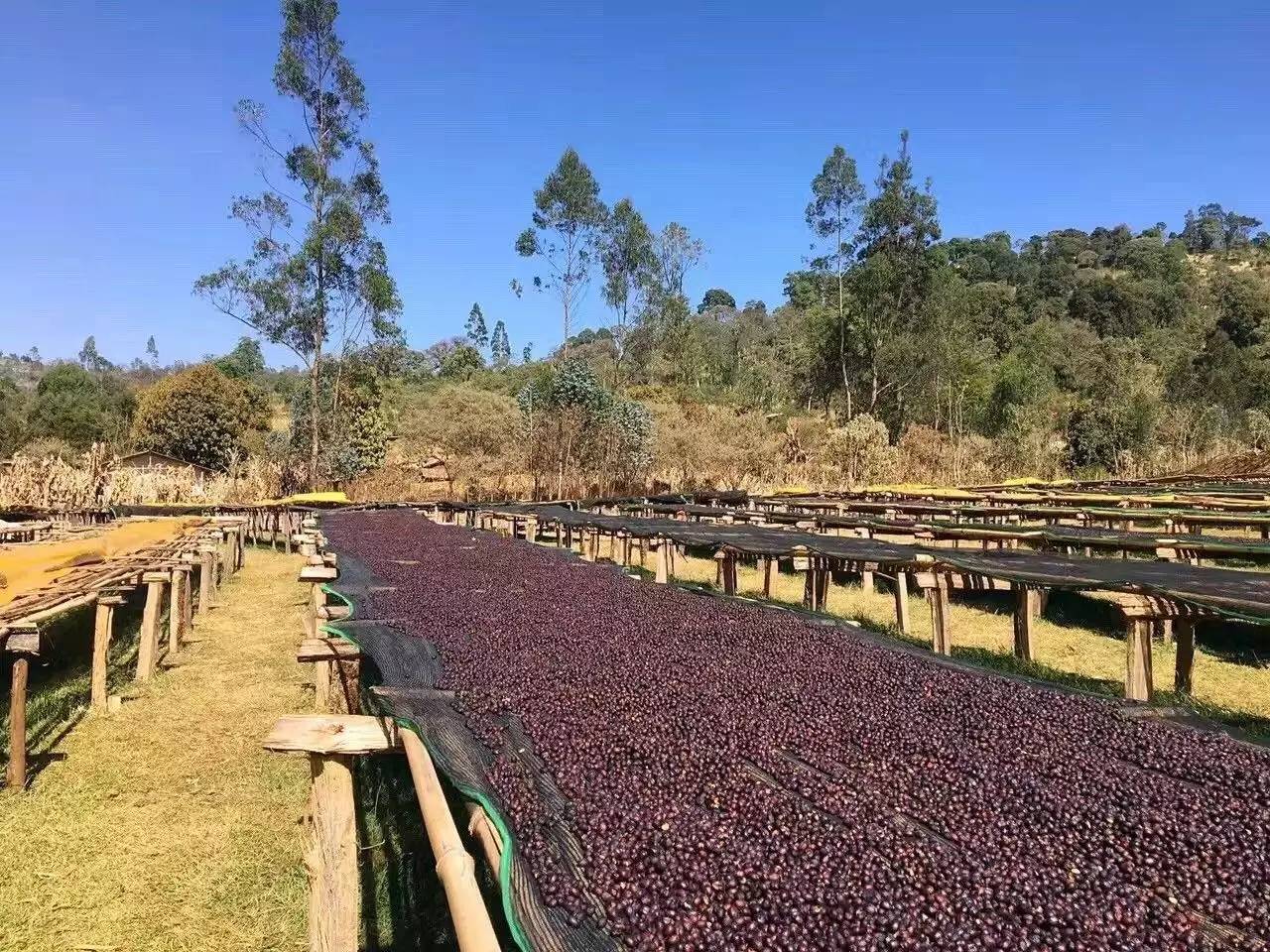
Washed complete washing method:
The peel, pulp and mucous membrane are removed by washing and fermentation. the treatment plant that uses the washing method must rely on the water source, build a washing pool, and be able to introduce an endless supply of live water. During the treatment, the finished beans are put into the pool and passed back and forth, using the friction of beans and the power of running water to wash the coffee beans until smooth and clean.
After washing, at this time, the coffee beans are still wrapped in the pericarp with a moisture content of 50%. They must be dried to reduce the moisture content to 12%, otherwise they will continue to be mellow, moldy and rotten.
Because of the shortage of water resources in Africa, water washing plants in many producing areas directly purchase freshly picked coffee cherries from different nearby villages or planting areas for unified treatment.

Appearance of coffee beans:
[sunflower kuisheng beans]: the body of the beans is smaller, yellowish in the green, and there is a great difference in particle size.
[washed Huakuisheng beans]: coffee raw bean green is grayish and the particle size is uniform.

[sun Huakui cooked beans]: the degree of baking is light, the color is light, and there is no silver skin.
[washed Huakui cooked beans]: the baking degree is slightly darker, the color is slightly darker, and there is silver residue in the middle line.
Start cup test
Cup test preparation:
The ratio of water to water: 8.2 Murray 8.3 grams of coffee beans with 150ml water, the ratio of water to powder is 1 to 18.18, and the water temperature should be 94 °C.
Cup test cup: toughened glass or ceramic materials should be used
Cup test capacity: between 207ml and 266ml
Diameter of cup mouth: 76-89mm, all cups should be made of the same volume, size and material.
Cup test spoons: to use antistatic metal material (mostly stainless steel), each spoon capacity can have 4-5ml.


Cup testing process:
1. The beans to be tested in the cup are ground into powder (degree of grinding: BG: 3B).
two。 Smell dry aroma
3. Pour hot water (94 degrees) into the cup until it is full and time for 4 minutes.
4. At the end of 2 minutes, smell the wet aroma
5. At the end of 4 minutes, the slag can be broken.
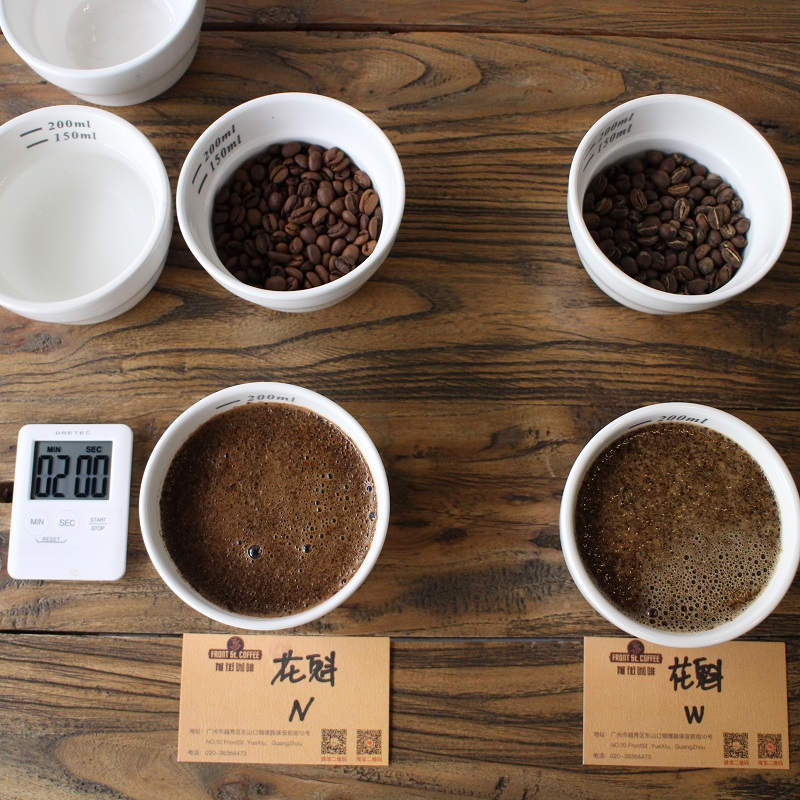
"broken residue": use a cup spoon to push away the coffee powder floating on the surface, make the aroma at the bottom burst out, confirm the aroma performance of the coffee, gently stir 3 times with the cup spoon and let stand for 2 minutes.
6. At the end of 2 minutes, you can pick up the slag.
"dregs": use a cup spoon to pick up the foam on the surface, and clean the cup spoon each time to avoid leaving a bad taste to affect the coffee.
7. Scoop up the coffee liquid with a cup spoon and test it by sipping. Sipping will make the coffee liquid fog in the mouth, the flavor molecules can be more clearly displayed.
8. Spit the coffee liquid from your mouth into the spitting cup.
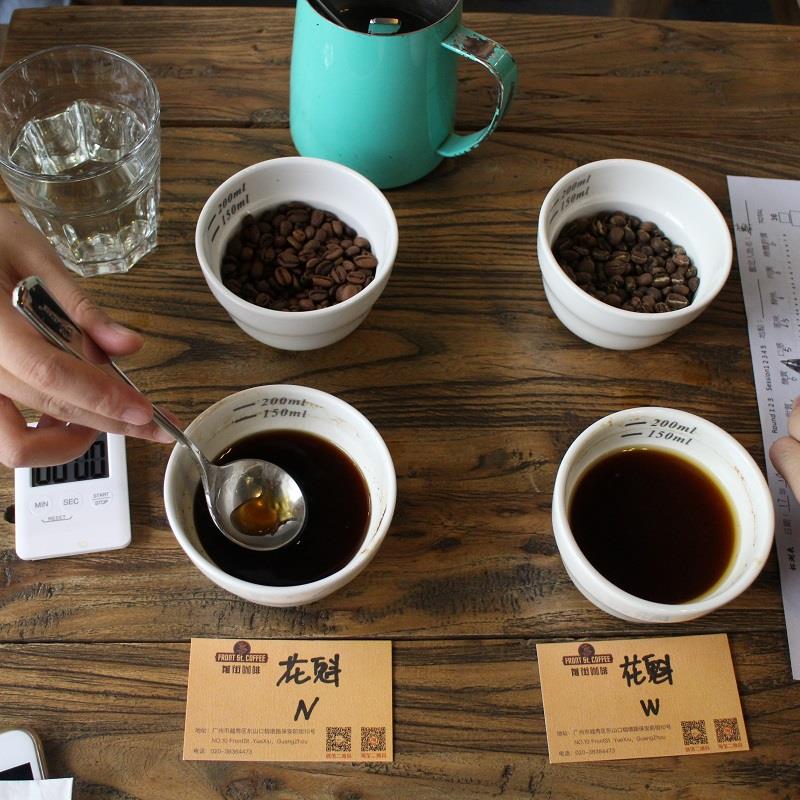
[cup test results] dry and wet incense:
[sunflower kui]: passion fruit, tree pineapple, strawberry
[washed Huakui]: tea fragrance, green orange.
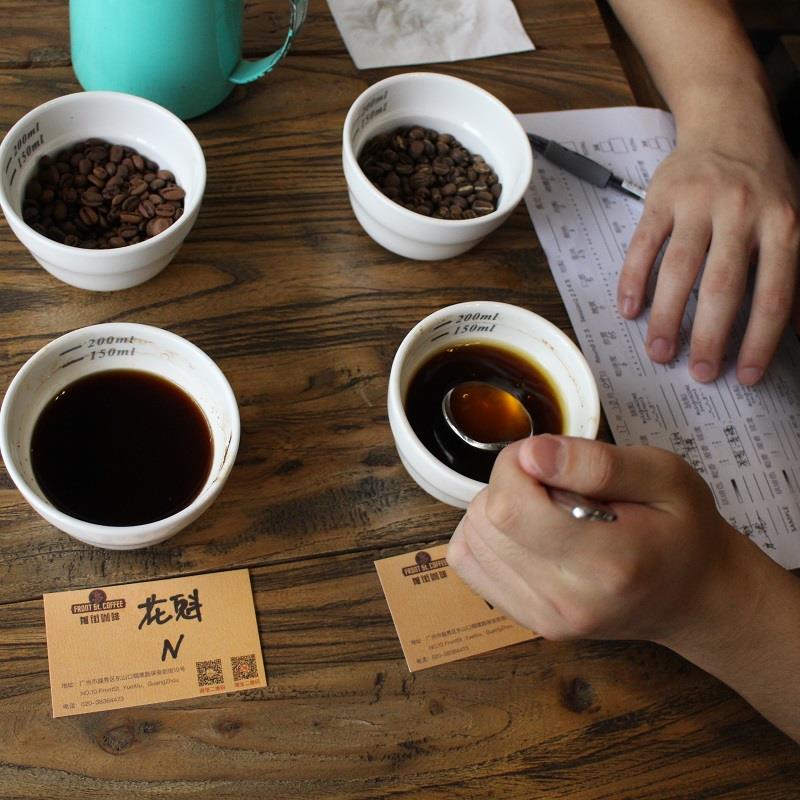
[cup test results] Flavor description and score:
[sunburn]: rose, passion fruit, tree pineapple, strawberry sweet and sour
Cleanliness: 6 points
Sweet: 6 points
Acid quality: 6 points
Taste: 5 points
Flavor: 6.5 points
Aftertaste: 6 points
Equilibrium: 6 points
Overall evaluation: 6 points
Total score: 83.5
[washed Huakui]: green tea aroma, green orange, flower fragrance, black tea tail rhyme.
Cleanliness: 6.5 points
Sweet: 6.5 points
Acid quality: 6 points
Palate: 6.5 points
Flavor: 6 points
Aftertaste: 6 points
Equilibrium: 6 points
Overall evaluation: 6 points
Total score: 85.5

A summary of the scores after several rounds of cup tests.
Hand punching parameters are recommended:
[sun Huakui]: it is recommended to use 15 grams of powder at 90 degrees water temperature, 3.5 Fuji grindability 3.5 V 60 filter cup, water powder ratio 1:15, the first water injection 30g, steaming 30s, the second water injection 104g water cut off, the second water injection to 225g water, not the water in the tail section, the extraction time is about 2Rd 02s.
[water washing Huakui]: it is recommended to use 15 grams of powder at 92 degrees water temperature, 3.5 Fuji grindability 3.5 V 60 filter cup, water powder ratio 1:14, the first water injection 30g, steaming 30s, the second water injection 110g water cut off, the second water injection to 215g water, not the water in the tail section, the extraction time is about 2Rd 05s.
Finally, the conclusion:
According to the cup test results, Sunshine Huakui is an excellent champion bean with outstanding flavor richness and outstanding performance in balance. I believe many people will like this bean.
On the other hand, the flavor of washed Sakuran is quite different from that of Sunshine, which is related to the varieties of Ethiopian coffee (native species) and the harvest and treatment system of the processing plant, but it still does no harm to the good quality of this bean, with its sweet and sour taste exploding, unique taste and obvious texture of black tea, which can even make people mistake it for beans from Kenya for a moment.
The choice of washing or in the sun is undoubtedly a problem that puzzles countless coffee lovers, but radish and green vegetables have their own preferences, whether it is the explosion of the flavor of sun beans or the endless drinking of water-washed beans, they are all worth trying and sharing. Therefore, in the cup test comparison between Sun Sakuran and Water-washed Sakuran, there is only a high or low score, and there is no difference in quality.
Important Notice :
前街咖啡 FrontStreet Coffee has moved to new addredd:
FrontStreet Coffee Address: 315,Donghua East Road,GuangZhou
Tel:020 38364473
- Prev
Private recipe] Black fungus Boba with soy milk coffee. Mother Ke plant bird's nest
For professional baristas, please follow the coffee workshop (Wechat official account cafe_style) ingredients or seasoning black fungus QQ circle (coffee) 1 cup coffee powder 1 packet of hot water 100ml soy milk 200ml brief introduction to the special flavor shared today, basically as long as the coffee flavor of black fungus QQ circle, directly added to the coffee and soy milk mixed drinks, do not drink ice, can also be made in advance
- Next
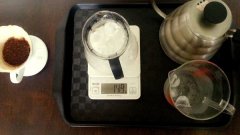
Hand-washing experiment of "Frozen Japanese Ice Coffee"
Communication of professional baristas Please follow the coffee workshop (official Wechat account cafe_style) saw an article on the Internet yesterday about the preparation of Japanese-style iced coffee. Why is it called Japanese iced coffee? I don't know either. However, everyone should think about this method of making iced coffee. This is exactly the same as hand flushing, except that you can put the ice in the heat-resistant kettle first.
Related
- What is the meaning of lactic acid fermentation with coffee bean treatment?
- How to judge the state of foam by sound?
- How does the latte pull out the unicorn pattern? Come to get for a little trick to improve the flower pull!
- Will flower pulling affect the taste of the latte?
- Do you know the history of coffee?
- The difference between honey treatment and sun washing what is raisin honey treatment?
- What kind of milk can a novice use to make coffee foam to keep the foam longer? The correct method and skills of milking tutorial sharing
- Why do washed coffee beans taste sour? Flavor characteristics of washed Coffee
- Introduction to the skill of how to practice the size and height of water injection around the circle of hand-brewed coffee
- How do beginners practice coffee flower drawing from scratch?

